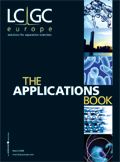Profiling and Characterization of Polyphenol Polymers from Cinnamon Using an Ion Trap Mass Spectrometer
The Application Notebook
Min He,1 Julian Phillips,1 Peter Wang,2 Ying Xiang,3 Ying Qi3 and Howard Sun,3
1 Thermo Fisher Scientific, San Jose, California, USA, 2 Thermo Fisher Scientific, Shanghai, China, 3 Shanghai R&D, Nu Sin Enterprises, Shanghai, China.
Type 2 diabetes is the most common metabolic disease worldwide. Although the prevention and control of it remains unclear, there is strong evidence that dietary factors play a role in the onset of this disease. Previous studies have indicated that cinnamon may mimic insulin effects and thus may improve glucose uptake.1,2

Figure 1
In this application, profiling and structural elucidation of polyphenol polymers, the possible active compounds in cinnamon, are performed using an LC–MSn methodology using the LCQ Fleet ion trap mass spectrometer.
Experimental Methods
An aliquot (0.5 g) of cinnamon was ground and extracted in 8 mL 0.1 N acetic acid using a sonic bath for 3 minutes. The supernatant liquid was cooled to room temperature and diluted in mobile phase. The final solution was filtered prior to HPLC separation. LC separation was performed using a C18 column and detected at 280 nm wavelength. Sample fractions CB4 with insulin enhancing activity were collected, and the powders were dissolved in water:MeOH:ACN 25:50:25 solvent for LC–MSn analysis.
Results
A range of procyanidins from cinnamon extract fractions have been identified and characterized within a rapid ten-scan-event LC–MSn analysis [Figure 1(a)]. The fast positive/negative switching the capability of the LCQ Fleet mass spectrometer ensured comprehensive structural information for compounds ionized in both positive and negative mode was collected in a single chromatographic analysis. Figure 1(b) and Figure 1(c) demonstrated the MSn (up to MS5 ) data of one trimer procyanidin in both positive [Figure 1(b)] and negative [Figure 1(c)] polarities from fraction CB4. The ability to perform MSn analysis on precursor ions (isolated using HRI) using the ion trap enables the structural elucidation of these compounds with less interference from the matrices. The presence of m/z 289 in negative MS–MS spectrum is considered to be specific for a C-O-C IFL in the polymers.4,5
Conclusion
A rapid and rugged LC–MSn method has been developed to characterize the various procyanidin oligomers in the Chinese cinnamon extract. Both A-type and B-type polymers were found. The fast cycle time and excellent MSn capability of the LCQ Fleet enabled the confident identification of the components of interest.
References
1. R.A. Anderson et al., Agric. Food Chem., 52, 65 (2004).
2. B. Mang et al., Euro. J. Clin. Invest., 36, 340–344 (2006).
3. S.M. Lampke et al., Poster on Experimental Biology, (2006).
4. W. Sun and J.M. Miller, J. Mass Spectrom., 38, 438 (2003).
5. S. Guyot, J. Vercauteren and V. Cheynier, Phytochemistry, 42, 5 (1996).

Thermo Fisher Scientific
355 River Oaks Parkway, San Jose, California 95134-1991, USA
tel. +1 800 532 4752 fax +1 561 688 8731
Website: www.thermo.com/lcqfleet

Silvia Radenkovic on Building Connections in the Scientific Community
April 11th 2025In the second part of our conversation with Silvia Radenkovic, she shares insights into her involvement in scientific organizations and offers advice for young scientists looking to engage more in scientific organizations.
Regulatory Deadlines and Supply Chain Challenges Take Center Stage in Nitrosamine Discussion
April 10th 2025During an LCGC International peer exchange, Aloka Srinivasan, Mayank Bhanti, and Amber Burch discussed the regulatory deadlines and supply chain challenges that come with nitrosamine analysis.
Polysorbate Quantification and Degradation Analysis via LC and Charged Aerosol Detection
April 9th 2025Scientists from ThermoFisher Scientific published a review article in the Journal of Chromatography A that provided an overview of HPLC analysis using charged aerosol detection can help with polysorbate quantification.









